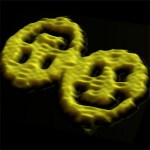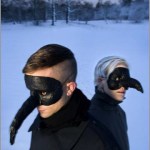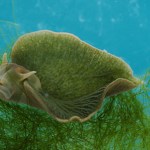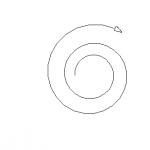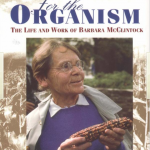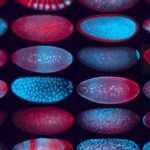
Awful Library Books has a post on books about genetic engineering from the 1970's and 80's, saying that it's time to get rid of them because "Genetic information is dramatically different from what we knew in the 70's and 80's. No mention of Human Genome Project or Dolly, the sheep." If you're looking for information about cutting-edge genetic engineering you're probably better off not looking for a book at all, but while science is inherently focused on the future, a historical perspective is almost always valuable, especially when it comes to genetic engineering and synthetic biology.
The…
Most synthetic biologists and biological engineers (and basically everyone else) think of DNA as code, simply carrying the information to make the RNA and proteins that do the real work inside the cell. In the past few years, a small group of biological engineers have used DNA instead as a physical substrate, a programmable nanomaterial to build all kinds of tiny shapes with (even smiley faces). The shapes that the DNA folds into depend on the sequence, which controls how different strands match up to each other and bend. For a great introduction to building shapes out of DNA in 2D and 3D…
There have been a lot of great Darwin themed things popping up in the past few months in celebration of the 150th anniversary of On the Origin of Species, but none as avant garde and awesome as "Tomorrow, in a year", an electro-opera based on the life and work of Charles Darwin by The Knife, a Swedish electronic music duo (and one of my favorite bands). From the website of the company performing the opera, Danish theater group Hotel Pro Forma:
An opera singer, a pop singer and an actor perform The Knife's music and represent Darwin, time and nature on stage. Six dancers form the raw material…
I just saw this neat blog post about Conway's Game of Life projected into three dimensions. You can download the script and play around with it yourself!
I am kind of obsessed with symbiosis and the idea that cooperation between different species can be a driver of evolutionary change. I learned about these symbiotic green sea slugs a while back from a colleague whose mom is a zoologist who studies the evolution of symbiosis between invertebrates and photosynthetic microorganisms. A review article from her lab beautifully introduces the amazing properties of Elysia chlorotica:
Faced with life without a protective shell in a predatory environment, some sea slugs evolved a protective mechanism dependent largely upon camouflage pro- vided by…
My first exposure to programming was as a nerdy elementary schooler playing with Logo, a simple computer language written for educational use as a way to teach basic concepts in programming and computer science. The language controls the behavior of the "turtle," a triangular cursor in the middle of the screen that can be programmed to move around and draw lines.
In one of the kid's versions I remember that the cursor even looked like a little turtle on the screen, not just a triangle. As you probably could tell, I'm fascinated by how computer scientists use language from living things and…
I just finished reading Evelyn Fox Keller's wonderful biography of Barbara McClintock, A Feeling for the Organism. Barbara McClintock was probably the best corn geneticist of all time and definitely one of the sassiest female scientists ever. In the 1940s and 1950s she discovered transposition, the process by which pieces of genes can literally jump out of one part of the chromosome and land back in another part. These jumping elements are controlled by master regulating elements in other parts of the genome and can turn different genes on and off at different times. This incredible discovery…
What does it mean to create life in a computer? In 1970, John Conway built a simple computer game where a user decides which boxes in a grid are populated and then hits start, letting the computer "evolve" depending on the initial conditions. Each "cell" of the grid can be "alive" or "dead" and has eight neighbors that determine its survival into the next "generation". The rules are pretty simple:
If a live cell has fewer than two (underpopulation) or more than three (overpopulation) live neighbors, it will die
if a dead cell has three live neighbors, it will come to life
and if a live cell…
My friend Devin's essay, "Making Cellular Memories" just came out today in Cell (and it's open access!) It's a great look at how natural cells and synthetic biological systems use feedback loops in order to maintain memory of past events. Like whole animals, cells need to remember what happened to them before in order to respond appropriately to new signals. Synthetic biologists can use memory to track cells that have experienced a certain input in a heterogeneous population, and to activate different responses depending on the historical context.
In sum, both nature's wisdom and previously…
Groups of individuals (from molecules to cells to animals) following simple rules and responding to environmental cues will create the amazingly complex emergent behaviors we see in nature, making cells, bodies, and societies far more than the sum of their parts. Each individual acts without knowing what the final outcome will be, whether it's birds flying in formation, termites building intricate underground tunnels, or human societies building cities and networks. At a molecular level, one of the most striking examples of emergent behavior is embryonic body pattern formation. Every cell in…
Hello! I'm so excited to be joining the ScienceBlogs community! I'll be focusing mostly on synthetic biology, defined in the past decade as two main approaches to life science research:
One uses unnatural molecules to reproduce emergent behaviours from natural biology, with the goal of creating artificial life. The other seeks interchangeable parts from natural biology to assemble into systems that function unnaturally. Either way, a synthetic goal forces scientists to cross uncharted ground to encounter and solve problems that are not easily encountered through analysis.
(from Benner and…

